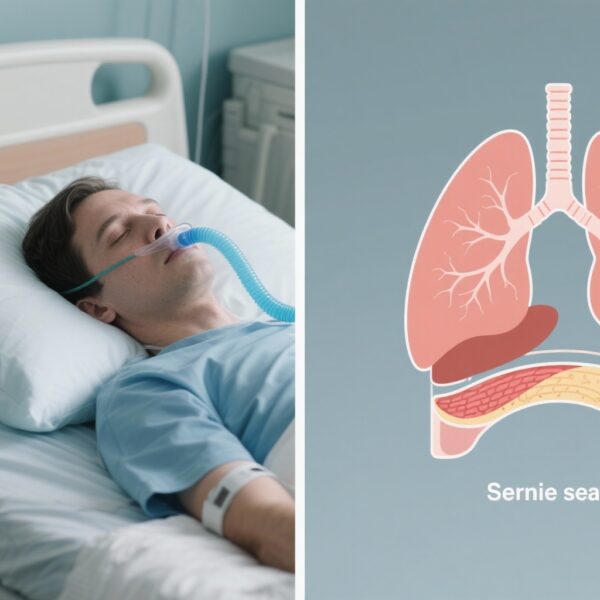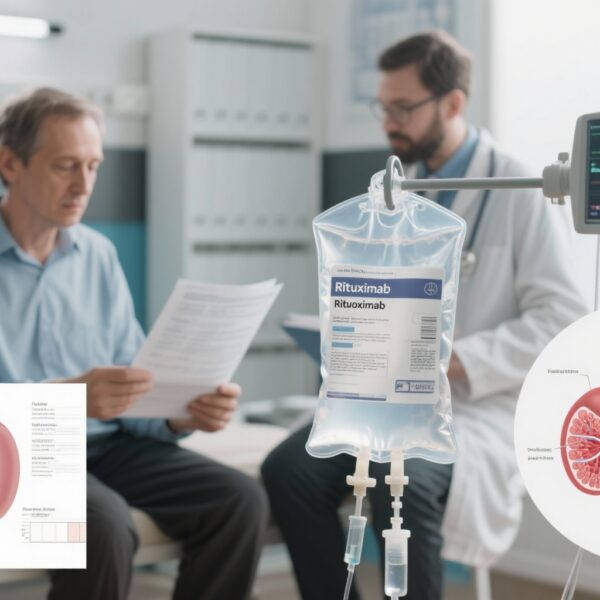Highlights
– In the randomized BICARICU-2 trial (n=627 analyzed), intravenous sodium bicarbonate targeted to raise arterial pH ≥7.30 did not alter 90‑day all‑cause mortality (62.1% vs 61.7%; absolute difference 0.4%; 95% CI −7.2 to 8.0; P = .91).
– Sodium bicarbonate use was associated with a clinically meaningful reduction in kidney replacement therapy (KRT) by day 90 (35% vs 50%; absolute difference −15.5%; 95% CI −23.1 to −7.8).
– No differences were observed in other secondary outcomes or adverse events; implications include limited support for routine bicarbonate infusion to improve survival, but potential utility to reduce dialysis exposure in selected patients.
Background and clinical context
Severe metabolic acidemia (commonly defined as arterial pH ≤7.20) occurs frequently in critically ill patients, often in the setting of sepsis, respiratory failure, or acute kidney injury (AKI). Severe acidosis can impair hemodynamics, reduce myocardial contractility, worsen catecholamine resistance, and perturb cellular metabolism. Consequently, many clinicians use intravenous sodium bicarbonate to correct pH acutely, aiming to stabilize physiology and avoid organ dysfunction or the need for KRT.
Despite plausible physiologic benefits, the effect of bicarbonate therapy on patient‑centered outcomes such as mortality and need for dialysis has been uncertain. Prior observational studies and small trials provided conflicting results. Guideline statements (e.g., KDIGO for AKI and sepsis guidelines) have not strongly recommended routine bicarbonate infusion for metabolic acidosis, reflecting limited randomized evidence for meaningful clinical outcomes.
Study design and methods
BICARICU-2 was an investigator‑initiated, multicenter, randomized, open‑label clinical trial conducted across 43 French intensive care units between October 6, 2019, and December 19, 2023, with 90‑day follow‑up (last follow‑up June 17, 2024). Adults with severe metabolic acidemia (arterial pH ≤7.20) and moderate to severe AKI were eligible. The trial randomized 640 patients 1:1 to receive either intravenous sodium bicarbonate infusion or no bicarbonate (standard care), with a target arterial pH ≥7.30 in the active arm.
The primary outcome was all‑cause mortality at day 90. Key secondary outcomes included day 28 and day 180 mortality; organ support needs (vasopressors, invasive ventilation, KRT); ICU and hospital length of stay; ICU‑acquired infections; fluid balance; day‑7 SOFA score; and major adverse kidney events at day 90. The analysis population comprised 627 patients (314 assigned to bicarbonate, 313 to control).
Key findings
Baseline characteristics: The median age was 67 years (IQR 59–74); sex distribution was balanced (≈60% male). The enrolled population exhibited high illness severity and a high baseline mortality risk.
Primary outcome
The 90‑day mortality was essentially identical between groups: 195 of 314 patients (62.1%) in the bicarbonate group and 193 of 313 (61.7%) in the control group. The absolute difference was 0.4% (95% CI −7.2% to 8.0%; P = .91), indicating no evidence of a survival benefit from bicarbonate infusion in this population.
Secondary outcomes
There were no significant between‑group differences in day 28 or day 180 mortality, ICU/hospital length of stay, vasopressor or ventilator‑free days, day‑7 SOFA score, or ICU‑acquired infections. Crucially, the use of kidney replacement therapy differed markedly: 109 of 314 (35%) patients in the bicarbonate group received KRT versus 157 of 313 (50%) in the control group (absolute difference −15.5%; 95% CI −23.1% to −7.8%). Other secondary outcomes and safety endpoints showed no convincing harm from bicarbonate therapy.
Safety
The trial reported no significant increase in adverse events attributable to bicarbonate infusion. Common theoretical concerns from bicarbonate therapy—such as volume overload, hypernatremia, paradoxical intracellular acidosis from CO2 generation, and hypocalcemia—did not translate into measurable excess complications in this study, although careful monitoring remains prudent.
Interpretation and clinical implications
BICARICU-2 provides high‑quality randomized evidence that, for critically ill patients with severe metabolic acidemia and concomitant moderate to severe AKI, routine infusion of sodium bicarbonate to raise arterial pH to ≥7.30 does not reduce 90‑day mortality. The neutral effect on survival is robust given the trial’s size and high event rate.
However, the substantial reduction in dialysis use is clinically important. A 15.5% absolute reduction in KRT suggests that bicarbonate therapy can meaningfully decrease the need for extracorporeal renal support in this population. Possible explanations include improved hemodynamics or renal perfusion with pH correction, reduced severity of AKI progression, or delayed crossing of clinical thresholds that prompt initiation of dialysis.
How should clinicians translate these findings? Key practical points:
- Do not expect sodium bicarbonate infusion to improve survival in unselected patients with severe metabolic acidemia and AKI.
- Consider bicarbonate infusion when the clinical goal is to avoid or delay KRT in patients at high risk for dialysis and where avoiding dialysis would meaningfully change outcomes or resource use—recognizing that reduction in KRT did not translate into mortality benefit in this trial.
- Maintain vigilance for volume, sodium, and acid–base management issues. Although no signal of harm was observed in BICARICU‑2, individual patient factors (e.g., severe heart failure, hypernatremia) may limit bicarbonate use.
Mechanistic considerations
Physiologically, correcting severe extracellular acidemia can improve cardiovascular performance, reduce vasopressor requirements, and normalize enzyme function. Yet, acidosis may be as much a marker of severe underlying illness (e.g., profound sepsis, multiorgan failure) as a direct mediator of mortality. If the dominant driver of death is irreversible organ injury or ongoing shock, correcting pH alone may not change the trajectory.
The observed KRT reduction suggests a renal functional benefit or an effect on clinical decision‑making. Bicarbonate may transiently improve acid–base balance and metabolic milieu sufficiently that nephrologists or intensivists defer KRT initiation. Whether bicarbonate prevents structural kidney injury or simply delays dialysis initiation requires further mechanistic and longer‑term renal outcome study.
Strengths and limitations of the trial
Strengths include randomized design, multicenter conduct across 43 ICUs, pragmatic enrollment of a high‑risk population, and clinically meaningful endpoints with 90‑day follow‑up. The sample size was large for an ICU acid‑base trial and captured a high event rate ensuring statistical precision for moderate effect sizes.
Limitations include open‑label design, which could influence clinician decisions on KRT initiation despite predefined criteria; the trial was conducted entirely in French ICUs, so applicability to other health systems warrants consideration; and the trial evaluated a target pH strategy rather than a tightly standardized bicarbonate dosing regimen, introducing some heterogeneity. The neutral mortality result does not exclude a small benefit or harm but makes large effects unlikely.
Unanswered questions and research priorities
Future research should address:
- Which patient subgroups, if any, derive mortality or renal‑recovery benefit from bicarbonate (for example, stratified by etiology of acidosis, timing of therapy, baseline AKI severity, or vasopressor dependence)?
- Mechanistic studies to determine whether bicarbonate prevents kidney structural injury versus merely delaying KRT initiation.
- Optimal bicarbonate dosing strategies and monitoring to maximize benefit and minimize fluid/sodium overload.
- Health‑economic analyses to quantify the value of reduced dialysis use (costs, ICU resource utilization, patient‑centered outcomes such as quality of life).
Conclusion
BICARICU-2 shows that intravenous sodium bicarbonate targeted to raise arterial pH ≥7.30 in critically ill patients with severe metabolic acidemia and moderate to severe AKI does not reduce 90‑day mortality, but is associated with a meaningful reduction in kidney replacement therapy. Clinicians should not expect a survival advantage from routine bicarbonate infusion but may consider bicarbonate as a strategy to reduce dialysis exposure in selected patients, balancing potential benefits against fluid and sodium loading and individual comorbidities. Further research should clarify which patients are most likely to benefit and whether reductions in dialysis translate to longer‑term renal or functional advantage.
Funding and trial registration
Trial registration: ClinicalTrials.gov Identifier: NCT04010630.
Funding: See the original publication for details on funding and sponsor roles (Jung et al., JAMA 2025).
References
1. Jung B, Jabaudon M, De Jong A, et al; BICARICU‑2 Study Group. Sodium Bicarbonate for Severe Metabolic Acidemia and Acute Kidney Injury: The BICARICU‑2 Randomized Clinical Trial. JAMA. 2025 Oct 29:e2520231. doi:10.1001/jama.2025.20231.
2. Kraut JA, Madias NE. Metabolic Acidosis. N Engl J Med. 2014;371: (review article on pathophysiology and clinical approach).
3. Kidney Disease: Improving Global Outcomes (KDIGO) Acute Kidney Injury Work Group. KDIGO Clinical Practice Guideline for Acute Kidney Injury. Kidney Int Suppl. 2012;2:1–138.
4. Evans L, Rhodes A, Alhazzani W, et al. Surviving Sepsis Campaign: International Guidelines for Management of Sepsis and Septic Shock 2021. Intensive Care Med. 2021;47(11):1181–1247.



